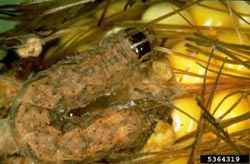New rearing method may help control of the western bean cutworm

The western bean cutworm is a destructive insect pest of dry beans and corn. Economic damage to corn occurs by larval feeding on ears, which is not controlled by commercial transgenic hybrids that express Bacillus thuringiensis (Bt) Cry1Ab, but partial control is observed by corn varieties that express Cry1 F toxins.<br><br>Credit: Frank Peairs, Colorado State University, Bugwood.org<br>
However, in an article in the Journal of Economic Entomology called “Evaluation of Tolerance to Bacillus thuringiensis Toxins Among Laboratory-Reared Western Bean Cutworm (Lepidoptera: Noctuidae),” the authors report a new rearing methodology used to maintain a laboratory colony for 12 continuous generations.
The ability to mass produce this pest insect will enhance fundamental research, including evaluation of control tactics and toxin susceptibility.
Economic damage to corn occurs by larval feeding on ears, which is not controlled by commercial transgenic hybrids that express Bacillus thuringiensis (Bt) Cry1Ab, but partial control has been observed by corn varieties that express Cry1 F toxins.
The new rearing procedure, described in the article, allowed the researchers to gather the first reported data for western bean cutworm susceptibility to Cry toxins using laboratory dose-response bioassays.
With the ability to rear western bean cutworm in the laboratory, it may be possible in the future to select strains with varying levels of Cry1F toxin susceptibilities, which could in turn be used to investigate the genetic basis of resistance.
Members of the media who would like an advanced copy of the article should write to rlevine@entsoc.org, or call 301-731-4535, ext 3009.
The Journal of Economic Entomology is published by the Entomological Society of America, the largest organization in the world serving the professional and scientific needs of entomologists and people in related disciplines. Founded in 1889, ESA today has more than 6,500 members affiliated with educational institutions, health agencies, private industry, and government. Members are researchers, teachers, extension service personnel, administrators, marketing representatives, research technicians, consultants, students, and hobbyists. For more information, visit http://www.entsoc.org.
Media Contact
More Information:
http://www.entsoc.orgAll latest news from the category: Ecology, The Environment and Conservation
This complex theme deals primarily with interactions between organisms and the environmental factors that impact them, but to a greater extent between individual inanimate environmental factors.
innovations-report offers informative reports and articles on topics such as climate protection, landscape conservation, ecological systems, wildlife and nature parks and ecosystem efficiency and balance.
Newest articles

A universal framework for spatial biology
SpatialData is a freely accessible tool to unify and integrate data from different omics technologies accounting for spatial information, which can provide holistic insights into health and disease. Biological processes…

How complex biological processes arise
A $20 million grant from the U.S. National Science Foundation (NSF) will support the establishment and operation of the National Synthesis Center for Emergence in the Molecular and Cellular Sciences (NCEMS) at…

Airborne single-photon lidar system achieves high-resolution 3D imaging
Compact, low-power system opens doors for photon-efficient drone and satellite-based environmental monitoring and mapping. Researchers have developed a compact and lightweight single-photon airborne lidar system that can acquire high-resolution 3D…





















